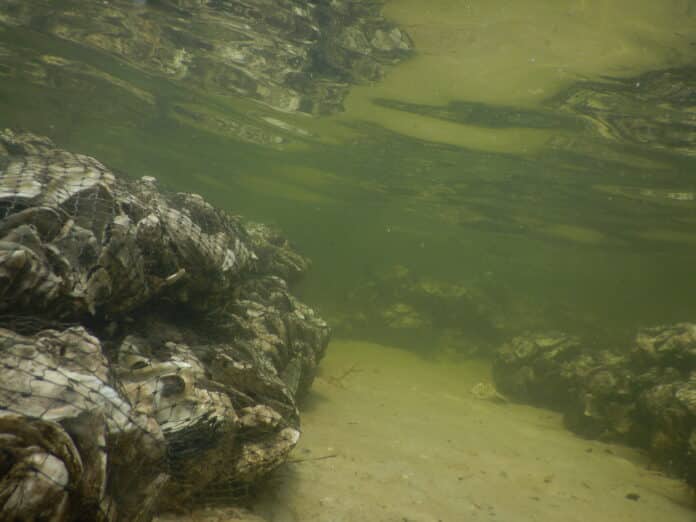The first man-made oyster reef was built with the help of numerous volunteers and boat captains on April 14, 2018 in Centipede Bay off the coast of Hernando County. Throughout the day a total of 98 volunteers and 12 boat captains helped to build the reef. Eighty percent of the reef was built with over 2400 bags of oyster shell placed. Hernando County, Aquatic Services Manager, Keith Kolosa, reports they are in the process of scheduling when the remainder of the work will be completed.
The mesh bags will help to create a substrate for the oysters to grow on. The spat (oyster larvae) settle on the shells and will grow into full-size oysters if conditions are right (salinity, temperature, depth). The timing of the reef deployment coincided with April oyster spawning. A preliminary project using recruitment tiles led by Brittany Hall-Scharf, Hernando County Sea Grant agent indicated that natural oyster spawning would be a sufficient method to populate the oyster shell substrate. Hall-Scharf explained that if natural recruitment isn’t as effective as hoped, then they will look into other methods of populating the reef such as hatchery-reared spat, or oyster larvae, to seed the site.
The Centipede Bay location was chosen because conditions tested seem favorable. Additionally, this Bay does not have much structure needed for oyster growth and is actually void of structure for fish. The oyster reef will increase both habitat and foraging area for fish and wading birds.
The bagging of the shell was accomplished with the help of over 100 volunteers over the course of seven different events that Hernando County Sea Grant agent Brittany Hall-Sharf coordinated.
The project would not have been possible without a $29,000 grant from the Florida Department of Environmental Protection, through the Coastal Partnership Initiative. The grant was spearheaded by UF Fisheries and Aquatic Sciences Asst. Professor Dr. Josh Patterson, Sea Grant Agent for Hernando County Brittany Hall-Scharf, and Savanna Barry, Regional Specialized Sea Grant Agent, Nature Coast. University of Florida faculty from different divisions are leading this project (UF/IFAS, Florida Sea Grant, and School of Forest Resource Conservation) and are partnered with Hernando County.
Some of the funding will be used to plant seagrass in the vicinity of the oyster reef with the help of a new ‘Grasses in Classes’ program at the Gulf Coast Academy of Science and Technology in Spring Hill.
Keith Kolosa stated, “It’s truly a great example of collaboration and partnerships and could not have been accomplished without community support and volunteers.”

